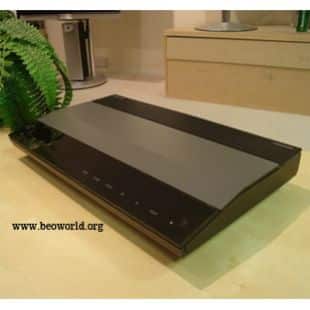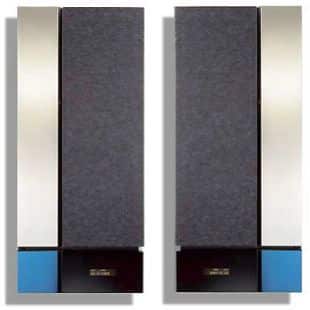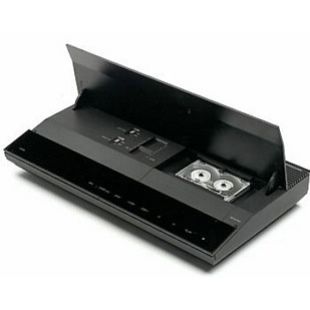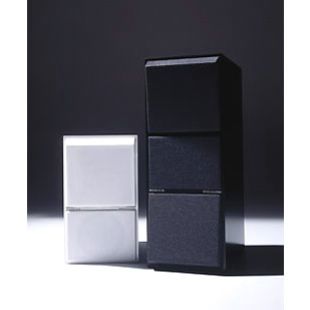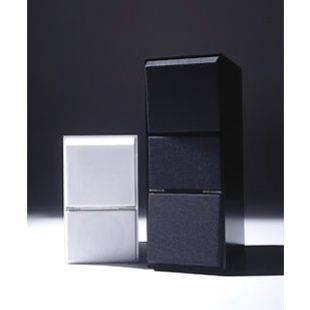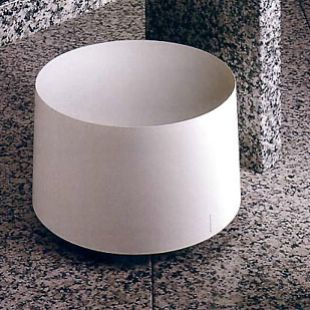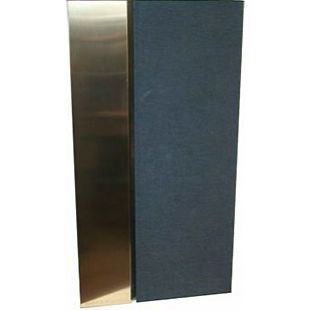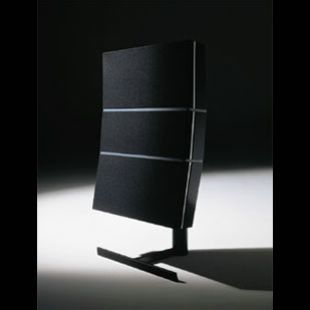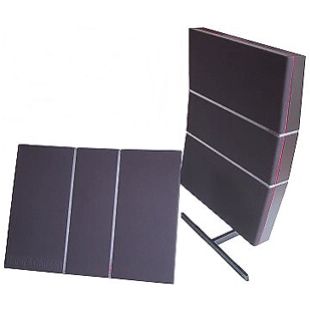BeoMaster 7000
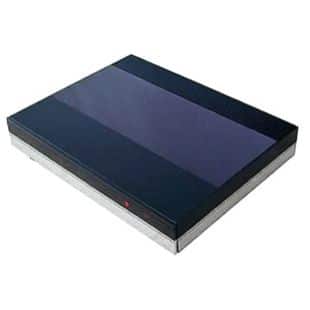
Beomaster 7000 was a receiver of high specifications and contained the system infra-red transceiver for communication with Beolink 7000 and the necessary computer to process and relay the commands to the other sources. Beomaster 7000 was the audio master and as such defined the system. Besides being a computer with considerable processing power, Beomaster 7000 also contained an FM/AM radio, the switch circuitry and the control- and power-amplifier.
Features:
Radio:
FM/AM frequency synthesis tuner, 24 presets. RDS decoder with access to FM transmitter name and operator. Naming of individual stations, both FM and AM, up to ten characters per station.
Amplifier Control section:
2 x 110 Watts long-term maximum output power. Automatic Power Handling Control, speaker and amplifier protection. Power Link connection for BeoLab active loudspeakers. Speaker Link connection for other loudspeakers (two pairs).
Connection for external power amplifier. Beolink® AV connection and complete AV operation facilities. Connection for Local Control System.
Audio Master:
Microcomputer, ROM capacity 64 KB, RAM capacity 1 KB, for the control of e.g. adjustments, source switching (audio and video), Automatic Power Handling Control, tuning, timer programming etc. Timer programming, 10 timer blocks. Battery backup for timer and clock. Dynamic display readout on Beolink 7000 of frequency, RDS and naming data, all tuning data, preset, FM/AM, sound adjustments.
Beomaster 7000 had a built-in RDS decoder which gave access to the basic 8 character RDS readout, the “PS” or “Programme Service Name”, i.e. an abbreviated readout of the transmitter name, the programme number and perhaps the name of the operator. The RDS data was displayed directly on Beolink 7000, when you selected a station that broadcast RDS information. This applied both when you were tuning or when you selected the preset that you had stored the programme on. Beolink 7000 displayed the RDS data also in situations when you were in a room equipped with Local Control System. Beolink 7000 was the only remote control capable of displaying RDS data.
The channel-naming facility allowed you to give every single radio station a name of your choice, with up to 10 characters, directly on the Beolink 7000. Naming could be carried out on all preset stations. Your favourite name had priority over a RDS name (if available) and was displayed when you selected the channel number.
The RDS and naming facility gave an added convenience with radio reception. The convenience level was paralleled with the reception quality of the FM tuner.
An FM tuner faces conflicting demands with regard to signal reception. It must have a high sensitivity for receiving weak stations (high selectivity), but it must also be able to suppress interference from powerful neighbouring stations. Beomaster 7000 was one of the few receivers that paid attention to these conflicting demands.
Components in high quality (e.g. dual-gate MOSFET transistors) and an optimised electronic design were used. The Intermediate Frequency (IF) stage had a bandwidth of approximately 200 kHz around the 10,7 MHz centre frequency (the IF filter contained three stable ceramic filters). Generally, if the IF bandwidth is broad, the selectivity falls, as does the intermodulation distortion. Conversely, if the bandwidth is narrow, the distortion and selectivity rise. This relationship must be compared with the reception conditions. If stations are close by (and powerful), the ideal is a narrow bandwidth, while distant (weak) stations require a wider band, in order to keep down the intermodulation distortion. In Beomaster 7000 the signal strength was measured for both the stations you received (within the filter range) and for stations that you didn’t want to receive, outside the filter range. This allowed Bang & Olufsen to suppress powerful stations on neighbouring frequencies and counteract intermodulation distortion, giving a high signal-to-noise characteristic for both weak and strong stations.
The stereo decoder gave an optimal stereo channel separation as long as the signal-to-noise ratio in the received signal was above 50 dB. When weaker signals were received, Beomaster 7000 automatically switched to mono. You could also select mono manually.
Tuning
The tuner was of the frequency-synthesis type, based on digital technology and controlled by the microcomputer. Tuning on FM was in steps of 50 kHz, in order to adhere to the cable network frequency allocation of 50 kHz. Tuning was carried out from Beolink 7000, either as a search tune up or down in the frequency range, or by direct frequency selection. There was automatic or manual fine-tune, with a precision better than 1 kHz.
AM Tuner
The (then) newly-developed AM tuner had a high reception sensitivity and was very stable and reliable. It was optimised for the Bang & Olufsen loop antenna, type no. 8720038. Automatic tuning was in steps of 9 kHz (USA: 10 kHz). The fine-tune operated in steps of 0.25 kHz.
Presets
24 presets were available. You could store any FM or AM station in any order and information such as fine tune, FM stereo/mono and AM manual tune was stored on the preset.
The Power Amplifier
The power amplifier in Beomaster 7000 was rated at 2 x 110 watts long term max. output, and it featured Automatic Power Handling Control as a protection for both the loudspeakers and the amplifier in case of overload or shorting. The circuit monitored the critical stage in the output amplifier and if prescribed limits were exceeded, the microcomputer lowered the volume to below the critical level.
The temperatures of the cooling surfaces were also measured and if the temperature got too high, the volume was also cut down. If the limits were exceeded again, the procedure was repeated. If the cause of the overload was eliminated, the volume could be turned up above the previous critical level. You would only under very special circumstances experience the Automatic Power Handling Control’s circuit overruling your volume setting, but when it did, it could save the system from serious damage. The circuit might have been activated, for example, if you connected several pairs of normal loudspeakers and played very powerful music extremely loudly. Another example could be if the loudspeaker outputs were short-circuited, in which case the Beomaster was simply switched to stand-by to protect the amplifier in an effective way. Similarly, if a defect occurred in the amplifier, the circuit protected the loudspeaker against direct current, which would otherwise destroy them.
If you connected BeoLab Penta or other active BeoLab speakers via the Power Link sockets, there was an independent protection circuit in the loudspeakers to protect them in a similar way.
Active cooling
Beomaster 7000 was very compact and in order to liberate heat from the power amplifier efficiently, a low-noise fan was placed at the bottom of the cabinet. If the cooling ribs of the output transistors reach a temperature of more than 50 degrees, the fan started up at low speed, rising to a maximum speed when the temperature was around 95 degrees. The amount of heat generated by the amplifier depended on how loud you played and for how long a period the volume was turned up. Only by playing very loudly for a prolonged time would the temperature rise and the fan start up, or the Automatic Power Handling Control interfere. Note also that if the recommended BeoLab Penta loudspeakers were connected, the power amplifier in Beomaster 70000 became inactive (or perhaps used to drive a Local Control System).
PowerLink Connection
The PowerLink connection in the receiver was used to connect BeoLab active speakers. The signal is a volume-adjusted line level signal and both left and right signals are carried in one cable, with data signals for a BeoLab status display. This means that it is no longer the socket on the Beomaster that decides whether it is the left or right channel. Instead a switch on the BeoLab loudspeaker has to be set to the correct position. PowerLink is very flexible with regard to connections. A pair of loudspeakers can be connected the usual way, with one cable to each loudspeaker, a BUS system can be applied where the signal is looped through one of the loudspeakers and then on to the next, or both methods may be combined if more than one pair of speakers needs to be connected. No matter which method is used, the correct setting of the L – R switch on the loudspeaker is essential. Up to 10 pairs and 100 metres of Power Link cable is recommended.
Socket Panel
The socket panel on the back of Beomaster 7000 was placed in a cut-out to prevent the connectors from protruding too far. As a consequence, the effective depth of Beosystem 7000 was virtually the same as the actual depth of the components. Apart from the CD, Tape 1, Tape 2, Phono and PowerLink sockets there were also connections for TV (or AUX), 2 pairs of Speaker Link for normal loudspeakers and Local Control System, FM/AM antenna sockets and a Line in/out socket for an external unit, e.g. an equaliser.
Note that the RIAA phono-preamplifier was placed in the Beogram 7000 and if a Beogram without RIAA was to be connected, a RIAA kit must be mounted in Beomaster 7000 by means of a minor service operation.
The battery backup in Beomaster 7000 retained all information in case of a power cut, where a quartz crystal was used as a reference for the clock.
Beomaster 7000 could, ideally, be used as part of Beosystem 7000.

